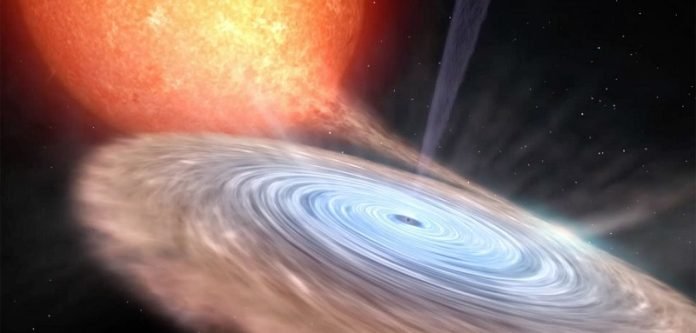
Scientists have long been intrigued by X-ray binary star systems, where two stars orbit around each other with one of the two stars being either a black hole or a neutron star.
Both black holes and neutron stars are created in supernova explosions and are very dense – giving them a massive gravitational pull.
This makes them capable of capturing the outer layers of the normal star that orbits around it in the binary system, seen as a rotating disc of matter (mimicking a whirlpool) around the black hole/neutron star.
According to theoretical calculations, these rotating discs should show a dynamic instability: about once an hour, the inner parts of the disc rapidly fall onto the black hole/neutron star, after which these inner regions re-fill and the process repeats.
Up to now, this violent and extreme process had only been directly observed once, in a black hole binary system.
For the first time, it has now been seen in a neutron star binary system, called Swift J1858.6-0814.
This discovery demonstrates that this instability is a general property of these discs (and not caused by the presence of a black hole).
The phenomenon was captured by combining data from five ground-based and space-based telescopes, together encompassing multiple wavelengths.
The scientific team, an international collaboration of astronomers led by the Instituto de Astrofísica de Canarias, formed ad-hoc when the neutron star system was first discovered in 2018.
These telescopes include the Karl G. Jansky Very Large Array: one of the world’s most sensitive radio telescopes, located in New Mexico, consisting of 27 massive (25-meter diameter) telescope dishes.
Dr Jakob van den Eijnden, from the University of Oxford’s Department of Physics, lead the analysis of the data from the Karl G. Jansky Very Large Array. He said: ‘Our observations of the radio wavelength data highlighted an important property of these instabilities.
We found that when the whirlpool empties, some of the gas is shot into space in so-called “radio jets”: narrow beams of gas shot out at speeds close to the speed of light.’
The brightness of these jets is observed to be variable, which is now explained by blobs of jet material being launched at these extreme speeds whenever the disc starts or finishes emptying out (causing peaks in brightness).
When the disc stabilises, the jets cease and the brightness reduces. Drawing this conclusion was only possible by comparing the variability observed with telescopes across the electromagnetic spectrum — from radio to X-ray wavelengths — which simultaneously probes the behaviour of the disc and the jet.
Dr van den Eijnden added: ‘This discovery, only the second example of these instabilities, also highlights the rarity of this behaviour. Therefore, finding more examples across different types of binary systems is a first priority.
Due to the transient nature of this process, it is unpredictable when we will get another chance. By then, we will need to be prepared to repeat our international observing efforts.’
The study ‘A shared accretion instability for black holes and neutron stars’ has been published in Nature.



